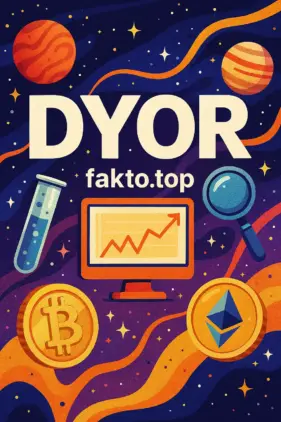DYOR for Beginners: The Ultimate Guide to Vetting Crypto Projects
DYOR Manual: The Comprehensive Step-by-Step Investigation for Crypto Safety
The Investigator’s Briefing
Every year, investors lose billions to hype, scams, and rushed decisions. FOMO, misleading social media, and unchecked influencer hype contribute to a staggering $10 billion lost annually. In this chaos, DYOR—Do Your Own Research—is your only shield. It transforms you from a passive follower into a Master Crypto Detective, equipped to analyze projects critically and protect your capital.
This guide divides your investigation into five detailed Case Files. Each file contains critical clues that must be verified before committing funds. From technical foundations to financial flow, security audits, regulatory compliance, and exit strategies, this manual equips you with the tools to spot red flags, recognize real value, and execute informed decisions. By the end, you will have a complete investigative framework for assessing any crypto project with confidence.

Case File 1: The Foundations (Technology & Team)
Clue #1: The Whitepaper – The Core Protocol
The whitepaper is your investigative blueprint. It should clearly articulate the problem the project solves, the technology behind it, and how it differentiates from competitors. Look for:
- Technical feasibility versus buzzwords.
- Competitive analysis and market positioning.
- Clear and realistic roadmaps with measurable milestones.
Vague claims, overuse of jargon, or promises without substance are immediate red flags. Compare the proposed solution with existing projects—does it genuinely innovate or merely replicate? Treat this document as your first critical piece of evidence.
Clue #2: The Team – Motive and Track Record
Behind every successful project is a team whose credibility can be verified. Investigate each founder and key contributor:

- Check LinkedIn and GitHub profiles for previous projects.
- Analyze prior successes and failures—have team members exited responsibly from past ventures?
- Evaluate transparency: fully anonymous teams are higher-risk unless the project prioritizes privacy.
A team with verifiable achievements and clear public history reduces the risk of fraud. Note any discrepancies or unverifiable claims—they are clues, not conclusions, but they inform risk management.
Clue #3: Development Health – The Vitals
Technical activity is the heartbeat of a project. Examine:
- GitHub repositories: recent commits, pull requests, and issue resolutions.
- Community engagement with code: active discussions, bug reports, feature requests.
- Project stagnation: inactive codebases or outdated libraries signal high risk.
Consistent and active development indicates a living project. Dead or poorly maintained repositories suggest the project might be abandoned or inadequately resourced. For a Master Crypto Detective, these vitals are non-negotiable evidence in your investigation.
Case File 1 equips you with the ability to distinguish between projects with substance versus those that exist primarily as hype. With technical foundations verified and the team vetted, you are ready to follow the money trail, analyze token distribution, and evaluate real-world adoption in Case File 2.
Case File 2: The Money Trail (Tokenomics & Distribution)
Clue #4: Distribution and Vesting – Concentration Risk
Understanding how tokens are allocated is critical. Review the token allocation map carefully. Questions to ask:
- What percentage of tokens is held by the team, advisors, or VCs?
- Are vesting schedules clearly defined to prevent early dumps?
- Does circulating supply match the roadmap and expected adoption?

High concentration of tokens with aggressive or absent vesting schedules creates significant risk. As a Master Crypto Detective, look for a balanced distribution where the team and investors are incentivized long-term, minimizing the potential for sudden market manipulation. Check tokenomics for concentration—this is your early warning system for unsustainable projects.
Clue #5: Utility and Demand – Total Value Locked (TVL)
Market cap alone doesn’t tell the whole story. TVL—Total Value Locked—offers a more accurate measure of real adoption and utility. Investigate:
- Active users and transaction volume.
- Protocols integrating the token.
- Stability and growth of the locked value over time.
High TVL indicates the token is actively used and trusted, whereas low TVL despite a high market cap signals potential hype without substance. Platforms like DefiLlama provide the necessary data. Consistently review transaction volume to gauge ongoing utility and demand. This step is crucial for understanding if your investment has staying power.
Clue #6: Liquidity Pool Analysis – Ease of Exit
Liquidity pools determine whether you can buy or sell without causing large price swings. Check:
- Pool size relative to your planned position.
- Depth of orders on decentralized exchanges.
- Historical slippage during transactions.
Low liquidity equals high slippage and potential manipulation. Use DEX trackers to verify pool depth and ensure you can exit safely. For beginners, this step prevents costly surprises when the market moves against you. Liquidity pool analysis is essential for realistic risk assessment.
Case File 3: The Security Audit (Code & Compliance)
Clue #7: The Smart Contract Audit – Forensic Integrity

Audits reveal the security posture of a project. Reputable firms like CertiK or SlowMist provide thorough reports. Key points to investigate:
- Critical vulnerabilities vs. minor issues.
- Resolved vs. unresolved findings.
- Audit scope and methodology.
Beware of cheap or superficial audits that offer little assurance. Audit results are evidence, not guarantees; however, they significantly reduce risk when properly interpreted. Smart contract audit results should align with best practices and community transparency.
Clue #8: Regulatory and Legal Status – Jurisdictional Risk
Compliance is increasingly important. Investigate:
- Whether the project enforces KYC/AML procedures.
- The jurisdiction it operates under and relevant regulations.
- Whether it actively avoids all legal oversight (a high-risk signal).
Projects skirting regulatory requirements may face shutdowns, legal actions, or fines, putting your capital at risk. For a Master Crypto Detective, identifying KYC/AML red flags and regulatory exposure is a vital step in assessing long-term safety.
Case Files 2 and 3 equip you with financial and security insights. You now know where tokens are concentrated, whether they are actively used, how easily they can be traded, and the integrity of the project’s code and legal standing. These clues form the backbone of a defensible investment strategy.

Case File 4: Risk Management & The Exit Strategy
Clue #9: Setting the Exit Strategy – The Detective’s Plan B
Every Master Crypto Detective knows that investigation doesn’t end with entry. Planning your exit is critical to protect capital and manage risk. Consider:
- Setting Take Profit targets to secure gains at predefined levels.
- Implementing Stop-Loss Orders to prevent catastrophic losses.
- Adjusting strategy based on market conditions and token performance.
DYOR includes anticipating potential pitfalls. A robust crypto exit strategy combined with risk management in crypto ensures you stay in control, even in volatile markets.
Clue #10: Recognizing Advanced Scams – The Deception
Beyond rug pulls, sophisticated scams include:
- Honeypots: contracts that allow buying but block selling.
- Social Engineering: phishing attempts, fake admins, or impersonated projects.
- Coordinated manipulation on social media to inflate perception.
Spotting these threats requires diligence. Investigate smart contract permissions, community transparency, and unusual patterns. Employ scam prevention techniques—never trust guarantees and always verify claims independently.
Table 2: Red Flags – Signs of a Scam Project
| Red Flag | The Danger | Evidence to Look For | Action to Take |
|---|---|---|---|
| Anonymous Team | Potential Rug Pull or exit scam | No verifiable LinkedIn/GitHub, hidden identities | AVOID until team is verified |
| No Lock on Liquidity | High risk of market manipulation or slippage | Liquidity not locked or traceable | CHECK liquidity locking, PROCEED WITH CAUTION |
| Aggressive Marketing Tactics | Pump-and-dump risk | Unrealistic promises, FOMO campaigns, spam posts | PROCEED WITH EXTREME CAUTION |
| Guaranteed Returns | Pyramid scheme or scam | “100x guaranteed”, high-risk claims | IGNORE and REPORT if possible |
| Regulatory Evasion | Legal shutdown risk, fines | No KYC/AML, ambiguous jurisdiction | Consider legal exposure, HIGH RISK |
Table 1: The Master Crypto Detective Checklist
| Investigation Category | The Clue to Follow | Where to Find the Evidence | The Verdict (Desired Outcome) |
|---|---|---|---|
| Foundations | Whitepaper Analysis | Official Project Docs | Clear Problem Solving & Feasible Technology |
| Foundations | Team Transparency | LinkedIn, GitHub | Doxxed & Experienced Team |
| Development | Active Code & Repo Health | GitHub, Community Repositories | Consistent Commits & Engagement |
| Financials | Tokenomics & Vesting Schedule | Project Docs, Token Allocation Maps | Fair Distribution, Transparent Vesting |
| Financials | Utility & TVL | DefiLlama, DEX Data, Active Users | High Adoption & Real Usage |
| Financials | Liquidity Pools | DEX Trackers | Sufficient Liquidity, Low Slippage |
| Security | Smart Contract Audit | CertiK, SlowMist, PeckShield | No Critical Vulnerabilities |
| Regulatory | KYC/AML & Jurisdiction | Project Website, Terms & Compliance Docs | Regulated, Low Legal Risk |
| Risk Management | Exit Strategy | Personal Trading Plan | Predefined Take-Profit & Stop-Loss |
| Risk Management | Advanced Scam Detection | Community Monitoring, Contract Analysis | Recognize Honeypots & Social Engineering |
The Final Verdict
DYOR is your ultimate personal risk manager. Every clue, from technical foundations to financial flows, security audits, and exit strategies, informs a responsible decision. Use the Master Crypto Detective Checklist consistently to ensure you never skip critical evidence. Remember, the verdict is yours: balance clues with your own risk tolerance, stay vigilant, and always consult a qualified financial advisor before committing funds.

The Final Verdict
The case is closed, but your vigilance must remain constant. You have successfully navigated the chaos of the crypto market, moving past FOMO and influencer hype.
By following the Master Crypto Detective Manual, you have examined all critical dimensions of project safety: evaluating the Whitepaper and assessing the Team in Case File 1, reviewing Tokenomics and Liquidity Pools in Case File 2, uncovering code weaknesses through the Smart Contract Audit in Case File 3, and accounting for Regulatory Risks in Case File 4.
Your final responsibility is to implement your pre-set Exit Strategy from Case File 5. Remember, DYOR is not a one-time task—it is an ongoing risk management process. Consistently use the Master Checklist to protect your investments from volatility and deception.
The ability to invest with confidence is in your hands, but verification must always guide your decisions.
